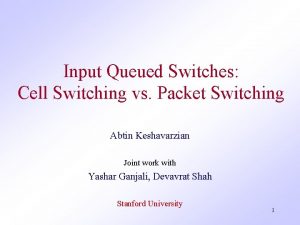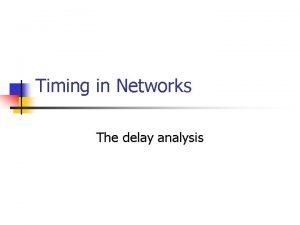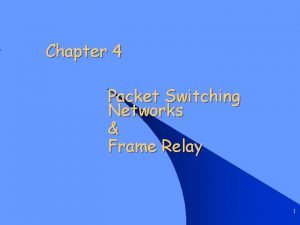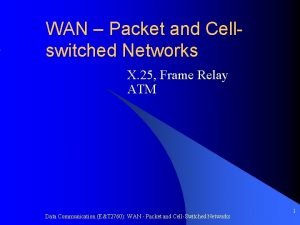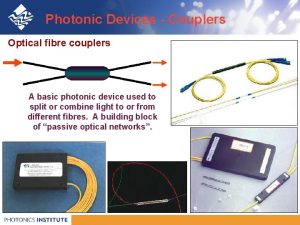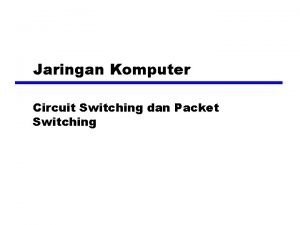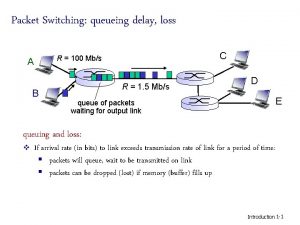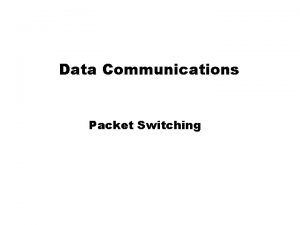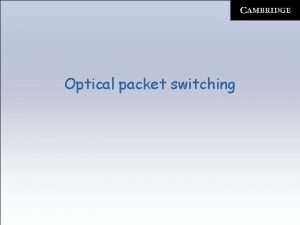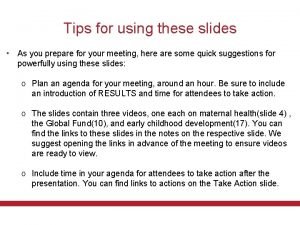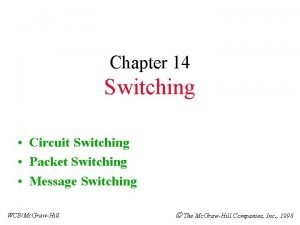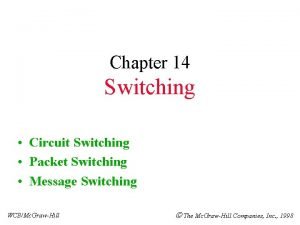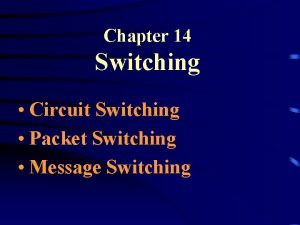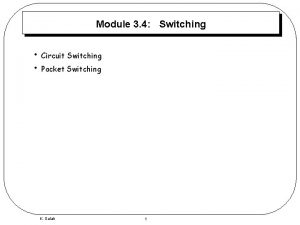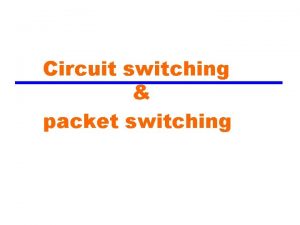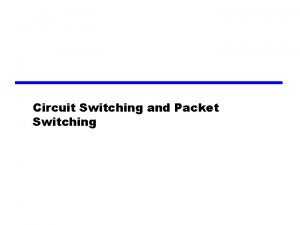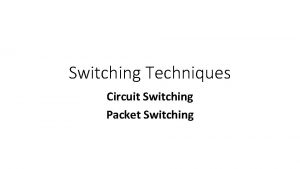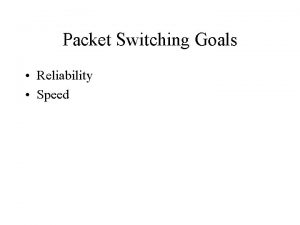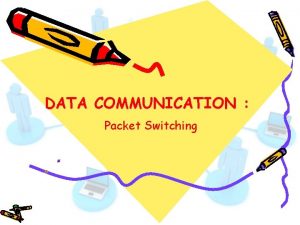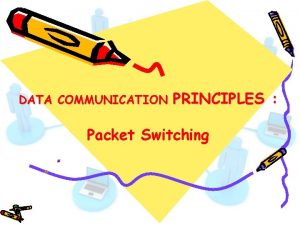Comp 410 AOS Packet Switching These slides derived





















- Slides: 21

Comp 410 AOS Packet Switching These slides derived from Computer Networking: A Top Down Approach , 5 th edition. Jim Kurose, Keith Ross Addison-Wesley, April 2009. Introduction 1 -1

The Network Core q mesh of interconnected routers q the fundamental question: how is data transferred through net? v circuit switching: Resources dedicated circuit per reserved call: telephone net v packet-switching: data sent thru net in Resources allocated discrete “chunks” on demand. Core Resources: buffers, link transmission rate Introduction 1 -2

The Network Core q The internet is packet switched q Telephone network is circuit switched Introduction 1 -3

Network Core: Circuit Switching End-end resources reserved for “call” q link bandwidth, switch q q q capacity dedicated resources: no sharing circuit-like (guaranteed) performance call setup required State maintained Data transferred at a guaranteed rate Introduction 1 -4

Network Core: Circuit Switching End-end resources reserved for “call” q Links between circuit switches q Each link can support n circuits q There can be n simultaneous connections. q Each circuit thus gets 1/n of the link’s bandwidth. Introduction 1 -5

Network Core: Circuit Switching network resources (e. g. , bandwidth) divided into “pieces” q pieces allocated to calls q dividing link bandwidth into “pieces” v frequency division v time division q resource piece idle if not used by owning call (no sharing) q When two hosts want to communicate network establishes a dedicated end-to-end connection between the hosts. Introduction 1 -6

Circuit switching: analysis q Disadvantages: v Network resources are wasted during “silent” times (when no one is talking but still connected) v Establishing end-to-end circuits and reserving end-to-end bandwidth is complicated and requires complex signaling software. q Advantage: v Guaranteed bandwith and transmission time v Necessary for some applications (streamed music/video) Introduction 1 -7

Network Core: Packet Switching transmission: q Each end-end data stream divided into packets q Each packet travels through communication links q Links connected by packet switches q Routers q Or link-level switches. q Switches use store-and-forward transmission q Switch receives entire packet before it transmits any of it again Introduction 1 -8

Network Core: Packet Switching transmission: Introduction 1 -9

Network Core: Packet Switching each end-end data stream divided into packets q user A, B packets share network resources q each packet uses full link bandwidth q resources used as needed Bandwidth division into “pieces” Dedicated allocation Resource reservation Introduction 1 -10

Packet-switching: store-and-forward L R R This Figure: q takes L/R seconds to transmit (push out) packet of L bits on to link at R bps q store and forward: entire packet must arrive at router before it can be transmitted on next link q delay = 3 L/R (assuming zero propagation delay) R Example: q L = 7. 5 Mbits q R = 1. 5 Mbps q transmission delay = ? ? v 15 sec more on delay shortly … Introduction 1 -11

Network Core: Packet Switching delays: q Each switch has multiple links q Each link has buffer q If packet arrives and another packet is already being transmitted on that link, must wait in queue q Called queuing delay. q Varies depending on network congestion q Packet loss: queue is full when packet arrives. Introduction 1 -12

Packet Switching: Statistical Multiplexing 100 Mb/s Ethernet A B statistical multiplexing C 1. 5 Mb/s queue of packets waiting for output link D On-demand sharing of resources is called statistical multiplexing E Sequence of A & B packets does not have fixed pattern, bandwidth shared on demand statistical multiplexing. TDM: each host gets same slot in revolving TDM frame. Introduction 1 -13

Packet switching versus circuit switching Packet switching allows more users to use network! q 1 Mb/s link q For each user assume: v 100 kb/s when “active” v active 10% of time q circuit-switching: v 10 users q packet switching: v with 35 users, probability > 10 active at same time is less than. 0004 N users 1 Mbps link Q: how did we get value 0. 0004? Introduction 1 -14

Routing q How do packets make their way through packet-switched Networks? Introduction 1 -15

Internet structure: network of networks q roughly hierarchical q at center: “tier-1” ISPs (e. g. , Verizon, Sprint, AT&T, Cable and Wireless), national/international coverage v treat each other as equals Tier-1 providers interconnect (peer) privately Tier 1 ISP Introduction 1 -16

Internet structure: network of networks q “tier-1” ISPs Form their own network v Each tier-1 ISP is connected directly to each of the other tier-1 ISPs v Each tier-1 ISP is connected to many tier-2 ISPs v Tier-1 providers know as the internet backbone Tier 1 ISP No group officially sanctions tier-1 status! Tier 1 ISP Introduction 1 -17

Tier-1 ISP: e. g. , Sprint POP: point-of-presence to/from backbone peering … … … to/from customers Introduction 1 -18

Internet structure: network of networks q “Tier-2” ISPs: smaller (often regional) ISPs v Connect to one or more tier-1 ISPs, possibly other tier-2 ISPs Tier-2 ISP pays tier-1 ISP for connectivity to rest of Internet q tier-2 ISP is customer of tier-1 provider Tier-2 ISP Tier 1 ISP Tier-2 ISPs also peer privately with each other. Tier-2 ISP Introduction 1 -19

Internet structure: network of networks q “Tier-3” ISPs and local ISPs v last hop (“access”) network (closest to end systems) local ISP Local and tier 3 ISPs are customers of higher tier ISPs connecting them to rest of Internet Tier 3 ISP Tier-2 ISP local ISP Tier-2 ISP Tier 1 ISP Tier-2 ISP local ISP Points of Presence (POP): a link or the group of routers in an ISP where other ISPs or customers connect. Tier-2 ISP local ISP Introduction 1 -20

Internet structure: network of networks q a packet passes through many networks! local ISP Tier 3 ISP Tier-2 ISP local ISP Tier-2 ISP Tier 1 ISP Tier-2 ISP local ISP Introduction 1 -21
 Message switching and packet switching
Message switching and packet switching Virtual circuit switching example
Virtual circuit switching example Cell switching vs packet switching
Cell switching vs packet switching Cell switching vs packet switching
Cell switching vs packet switching Advantages of circuit switching
Advantages of circuit switching Comp 410
Comp 410 Difference between virtual circuit and datagram networks
Difference between virtual circuit and datagram networks Circuit switching timing diagram
Circuit switching timing diagram Packet switching principles
Packet switching principles Frame relay packet switching
Frame relay packet switching X 25 wan
X 25 wan Bragg filtering
Bragg filtering Circuit switched network adalah
Circuit switched network adalah Four sources of packet delay
Four sources of packet delay Principles of packet switching
Principles of packet switching Optical packet switching
Optical packet switching A small child slides down the four frictionless slides
A small child slides down the four frictionless slides Starting from rest a marble first rolls down
Starting from rest a marble first rolls down These slides
These slides Teacher gists
Teacher gists Following slides
Following slides Iat 410
Iat 410



